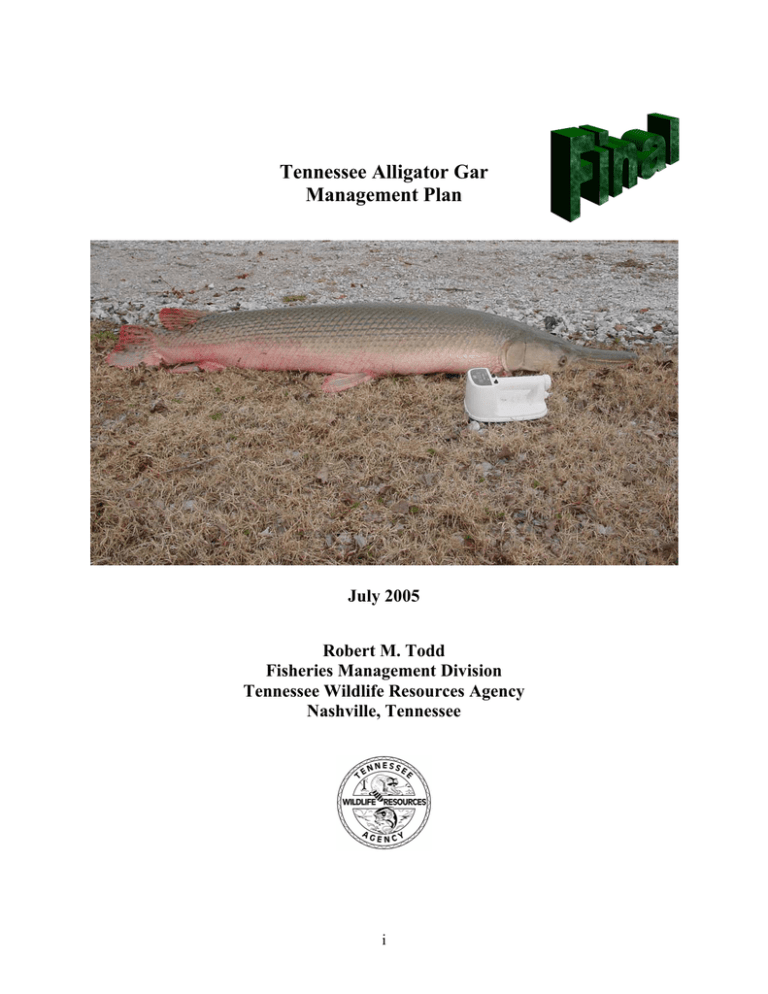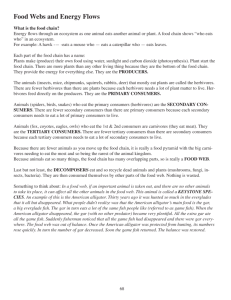Tennessee Alligator Gar Management Plan
advertisement

Tennessee Alligator Gar Management Plan July 2005 Robert M. Todd Fisheries Management Division Tennessee Wildlife Resources Agency Nashville, Tennessee i Tennessee Alligator Gar Management Plan July 2005 Written by Robert M. Todd Fisheries Management Division Tennessee Wildlife Resources Agency Nashville, Tennessee Approved by Ron Fox, Assistant Director William C. Reeves, Chief of Fisheries Gary Cook, Region 1 Manager Clarence Coffey, Region 3 Manager Steve Patrick, Region 2 Manager Bob Ripley, Region 4 Manager ii Table of Contents Forward………………………………………………………………………………………iv Acknowledgements…………………………………………………………………………..v Current Status………………………………………………………………………………...1 Historical Range………………………………………………………………………1 Population Status……………………………………………………………………..1 Life History……………………………………………………………………………1 Habitat………………………………………………………………………………...2 Goal……………………………………………………………………………………………2 Primary Objectives…………………………………………………………………………..2 Primary Objective 1. Restore alligator gar populations in suitable waters within their historic range of the West Tennessee Mississippi River Basin…………..2 Primary Objective 2. Monitor growth, survivability, and habitat use of stocked alligator gar…………………………………………………………………………..4 Primary Objective 3. Inform the public of alligator gar restoration and enhancement efforts in Tennessee……………………………………………………6 Secondary Objectives……………………………………………………………………….7 Secondary Objective 1. Determine if population abundance and structure is sufficient to consider allowing a sport fishery for alligator gar in selected waters…………..7 Secondary Objective 2. Develop and propose appropriate regulations to the Tennessee Wildlife Resources Commission to manage the alligator gar resource as a sustainable sport fishery…………………………………………………..…..7 Research Needs…………………………………………………………………………….8 Literature Cited……………………………………………………………………………8 Figure 1……………………………………………………………………………………..9 iii Foreword The purpose of this plan is to identify the Tennessee Wildlife Resource Agency (TWRA)’s goals, objectives, and strategies for the management of alligator gar in the state of Tennessee. The plan will provide a foundation for recommendations for restoration and enhancement activities to the Tennessee Wildlife Resources Commission. iv Acknowledgements This plan is based upon current knowledge of the status of the alligator gar resource as provided for in the literature and standard stream survey sampling efforts by TWRA Region I Fisheries personnel. The plan was reviewed by Alan Peterson, Non-game Biologist for Region 1; Tim Broadbent, Fisheries Biologist for Region I; Richard Kirk, Non-game Coordinator for the Nashville Office; Bobby Wilson, Assistant Chief of Fisheries Management Division; Bill Reeves, Chief of Fisheries Management Division; and Richard Campbell, Manager of Private John Allen National Fish Hatchery, U.S. Fish and Wildlife Service, in Tupelo, Mississippi. I would also like to thank Richard Campbell, Manager of Private John Allen National Fish Hatchery, U.S. Fish and Wildlife Service, in Tupelo, Mississippi for the alligator gar picture used on the cover page of this document and Susan Lanier for her assistance in map design of alligator gar sighting and stocking locations. v Current Status Historical Range The historical range for alligator gar is all the waters within the Mississippi River basin in Tennessee (Etnier, 1993). The waters within the Mississippi River basin in Tennessee include: the Mississippi River, the Obion River, the Forked Deer, the Hatchie River, the Loosahatchie River, the Wolf River, and Reelfoot Lake. Population Status Currently alligator gar is listed by Tennessee as a species in-need-of-management. Etneir (1993) stated that alligator gar may actually be extirpated from the state, and if not extirpated, low population abundance would justify endangered status in Tennessee. Very few reports of alligator gar are known. Confirmation of some sightings is problematic due to species identification problems by those that report sightings. The most recent confirmed wild alligator gar sighting was reported by TWRA Region I Fisheries personnel on April 13, 1999 during electrofishing sampling efforts at the confluence of the Obion and Forked Deer Rivers. They were unable to capture the fish but estimated the fish weighed about 70 pounds. Alligator gar stocking efforts in cooperation with the U.S. Fish and Wildlife Service, have begun on sections of the Obion River and the Forked Deer River. On July 30, 1999, 300 alligator gar fingerlings from Private John Allen National Fish Hatchery were stocked into the South Fork of the Obion River and 25 fingerlings were stocked into the Middle Fork of the Forked Deer River. On August 17, 1999, 100 alligator gar fingerlings from Private John Allen National Fish Hatchery were stocked into the South Fork of the Forked Deer River. On July 12, 2001, 61 alligator gar fingerlings were stocked in the North Fork of the Forked Deer River and 61 alligator gar fingerlings were stocked in the Hatchie River. All alligator gar stocked were eight to thirteen inches in length and in 2001 tagged with a binary coded wire tag. Figure 1 illustrates the locations of all alligator gar sightings and stocking locations in Tennessee waters from 1999 to present. Life History There is little known about the life history of alligator gar. Spawning occurs during April through June, coinciding with the seasonal flooding of bottomland swamps, thought to be important spawning habitat. Females lay large, sticky eggs in vegetated shallow waters. Adults provide no parental care for their young. Alligator gar inhabit the pools of slow moving backwaters in large rivers and swamps. The alligator gar is the largest of the gars and individuals from six to eight feet in length have been regularly reported. The maximum reported size of an alligator gar is 9-feet, 8-inches in length that weighed 302 pounds (Suttkus, 1963). The diet of alligator gar consists of fish (primarily shad and rough fish), turtles, waterfowl, and small mammals of appropriate size. They have also been known to scavenge discarded chicken and fish carcasses. 1 Habitat Alligator gar prefer areas with sluggish pools and backwaters of large rivers and swamps. They are adapted to survival in low-quality waters. Larvae have been collected from vegetated backwater sloughs in late May. Juveniles have been collected from shallow embayments associated with plant debris in July. Much of the habitat that alligator gar prefer has been lost through modifications such as channelization and levee construction. Goal The goal of Tennessee’s alligator gar management plan is to restore alligator gar populations in suitable waters within their historic range of West Tennessee associated with the Mississippi River Basin to establish a sport fishery when population abundance and structure allows. The goal of this management plan will be realized when the following criteria are met for the alligator gar population in West Tennessee 1) Natural reproduction is evident, 2) Contains 10+ year classes of adults > 7 years old, 3) All significant portions of West Tennessee are occupied or accessible to population, 4) Some level of harvest can be supported, and 5) Above average natural recruitment 1 out of 5 years. Primary Objectives • Restore alligator gar populations in suitable waters within their historic range of the West Tennessee Mississippi River Basin. • Monitor growth, survivability, and habitat use of stocked alligator gar. • Inform the public of alligator gar restoration and enhancement efforts in Tennessee. Secondary Objectives • Determine if population abundance and structure is sufficient to consider allowing a sport fishery for alligator gar in selected waters. • Develop and propose appropriate regulations to the Tennessee Wildlife Resources Commission to manage the alligator gar resource as a sustainable sport fishery. Primary Objective 1. Restore alligator gar populations in suitable waters within their historic range of the West Tennessee Mississippi River Basin. Alligator gar have been sighted only once in the past fourteen years of routine stream sampling through their historic range in West Tennessee by TWRA biologists. In addition, TWRA 2 reservoir biologists have never reported collecting or seeing an alligator gar from Reelfoot Lake. TWRA has not received a confirmed sighting of alligator gar by the public in recent years. Etnier (1993) suggested that endangered status in Tennessee could be justified for alligator gar due to extremely low population density, if they are not actually extirpated. Interest in restoring alligator gar in Tennessee has been communicated to TWRA by the Wolf River Conservancy. The Tennessee Wildlife Resources Agency proposes to initiate a restoration program by stocking alligator gar within their historic range in West Tennessee in cooperation with the U.S. Fish and Wildlife Service. Alligator gar restoration efforts have already begun. On July 30, 1999, 300 alligator gar fingerlings from Private John Allen National Fish Hatchery were stocked in the South Fork of the Obion River and 25 fingerlings were stocked in the Middle Fork of the Forked Deer River. On August 17, 1999, 100 alligator gar fingerlings from Private John Allen National Fish Hatchery were stocked in the South Fork of the Forked Deer River. On July 12, 2001, 61 alligator gar fingerlings were stocked in North Fork of the Forked Deer River and 61 alligator gar fingerlings were stocked in the Hatchie River. All alligator gar stocked were eight to thirteen inches in length and in 2001 tagged with a binary coded wire tag. Figure 1 illustrates the locations of all alligator gar stocked in Tennessee waters from 1999 to present, the locations of alligator gar sightings as reported in Etnier (1993), and a sighting reported by Region I fisheries personnel. Strategies: 1. Alligator gar should be cultured in a manner consistent with programs developed for atrisk species to reduce the possibility of outbreeding depression due to loss of adaptation or coadaptation and genetic swamping. Tasks: 1.1 All adult alligator gar used for brood stock should be collected from Lower Mississippi River Basin waters and from the wild annually, if possible, and pittagged for identification purposes. Brood stock should not be used for breeding purposes more than once, if possible. Family lots of fertilized eggs and juveniles should be kept separate with the same number of fish from each lot used for annual stocking. The U.S. Fish and Wildlife Service currently uses the above described culture and rearing programs for alligator gar used in this restoration and enhancement program. 1.2 When resources are available, cryopreservation techniques should be developed for alligator gar gametes. Development of these techniques will potentially alleviate the problem of obtaining ripe members of both sexes at approximately the same time. The U.S. Fish and Wildlife Service’s Warm Springs Fish Technology Center and PVT John Allen NFH are potential sources for development of these techniques. 1.4 Genetic samples (fin clips) should be maintained for future reference on all alligator gar collected, regardless of whether they are used as broodfish or not. 3 These samples will be invaluable to genetically delineating populations and within-population structure. The U.S. Fish and Wildlife Service’s Warm Springs Fish Technology Center could potential analyze these tissue samples and serve as their repository. 1.5 In cases where captive broodfish are used for spawning, every effort should be made to conduct a genetic evaluation to determine the pairing of least-related individuals. The U.S. Fish and Wildlife Service’s Warm Springs Fish Technology Center and PVT John Allen NFH are potential sources for conducting these analyses. 1.6 When broodfish numbers allow and resources are available, a portion of the broodfish should be spawned using alternative methods (e.g., striped spawned and tank spawned; Human Chorionic Gonadotropin (HCG), Lutenizing Hormone Releasing Hormone Analog (LHRHa), and Common Carp Pituitary (CCP) induction) to determine the best culture practices for this life stage. 1.7 When fry numbers allow and resources are available, fry should be cultured by alternative methods to determine the best culture practices for this life stage. 1.8 When resources are available, a propagation plan detailing all of the measures and procedures alluded to in Tasks 1.1 through 1.7 should be developed. 2. Conduct alligator gar habitat surveys in West Tennessee waters of the Mississippi River Basin to determine the location and amount of suitable habitat for these fish. 3. Stock tagged fingerling alligator gar into waters with suitable habitat at a density of five fish per acre, if possible. Little information is available on population densities in the wild, but low population densities are probable. Low stocking densities will reduce competition for food and territorial behavior conflicts, which should improve survival of stocked fish and also reduce potential impacts on other desired game fish inhabiting the same waters. Primary Objective 2. Monitor growth, survivability, and habitat use of stocked alligator gar. Little is known about growth, survivability of stocked fish, and habitat use by various life stages of alligator gar. The TWRA will collect data to address information gaps of these life history parameters. Strategies: 1. Tag all alligator gar stocked in Tennessee waters in order to identify individual fish to obtain known growth data when fish are recovered by sampling efforts. Tasks: 4 1.1 Alligator gar released as fry should be marked with oxytetracycline (OTC) or other suitable markers. Target: 1.1.1 1.2 An easily detectable mark should be retained by >95% of the fry before they are stocked. Mark retention estimates should be determined by random sampling. Alligator gar released as advanced fingerlings should be tagged with coded-wire tags (CWT) and/or passive integrated transponder (PIT) tags and/or external anchor tags. Target: 1.2.1 Tags should be retained by >95% of the fingerlings before they are stocked. Tag retention estimates should be determined by random sampling. 1.3 When resources are available, tag retention studies should be conducted for a period of up to six months post-stocking to determine tag retention. Target: 1.4 1.3.1 Tag retention for known-tagged fish should exceed 90% for the period of study for CWT and PIT tags. 1.3.2 Tag retention for know-tagged fish should exceed 75% for the period of study for external anchor or other similar type tags. When resources are available, short-term survival of stocked fish should be determined. Stocked fish should be placed into appropriately-sized cages at the stocking sites and their survival determined for a period of 48 hours. Survivability estimates from these studies should be used to estimate actual stocking numbers. Target: 1.4.1 Mean short-term survival of all alligator gar stocked within a season should exceed 80%. 1.5 When resources are available, a stocking plan detailing all of the measures and procedures alluded to in Tasks 1.1 through 1.4 should be developed. 2. Sample locations in which alligator gar have been stocked to obtain length and weight data. Use length and known age data from tagged alligator gar to develop catch curves for use in calculating mortality rates which will also provide a measure of survivability. 5 3. Sample locations in which alligator gar have been stocked to obtain habitat use data. Tagged fish will provide habitat use data for different life stages if habitat use varies. Primary Objective 3. Inform the public of alligator gar restoration efforts in Tennessee. The public is unaware that alligator gar are native to West Tennessee waters. Low abundance of alligator gar has contributed to this problem. Some people, that are aware of alligator gar, may have received misinformation about this fish such as: they attack people; they are large consumers of sport fish; etc. Public outreach is necessary to educate the public about this fish and the restoration program for them to realize the recreational opportunities and value of restoring and enhancing this resource. Alligator gar fishing in Arkansas during the 1950’s supported a lucrative recreational fishery that was nationally renowned until overexploitation and habitat modification decimated the populations. Tennessee Wildlife Resources Agency has begun an outreach program by providing news releases of our stocking efforts. Strategies: 1. Provide the media with news releases on alligator gar stocking efforts annually. 2. Provide the public with information regarding alligator gar life history and restoration efforts on TWRA’s webpage. 3. Provide information to the sport fishing public through news releases on the food habits of alligator gar to allay concerns that these fish could have a negative impact on game fish populations. 6 Secondary Objective 1. Determine if population abundance and structure is sufficient to consider allowing a sport fishery for alligator gar in selected waters. Alligator gar has the potential of being an attractive game species for sport fishers and bow hunters. Alligator gar fishing in Arkansas during the 1950’s supported a lucrative recreational fishery that was nationally renowned until overexploitation and habitat modification decimated the populations. Restored alligator gar populations that are properly managed for sustainable harvest could provide many additional sport fishing recreational man-days. Strategies: 1. Monitor alligator gar populations that have been restored through in-the-field surveys and collect data to determine if populations have become sufficiently abundant with the necessary structure to allow for a sport fishery for this species. 2. Since alligator gar populations could probably support only low exploitation levels, survey sport fishers to determine their thoughts on what an excellent alligator gar fishery would be. Secondary Objective 2. Develop and propose appropriate regulations to the Tennessee Wildlife Resources Commission to manage the alligator gar resource as a sustainable sport fishery. It will take several years for alligator gar populations to develop the abundance and structure through restoration efforts to allow for a sport fishery. Opinions by sport fishers on what is a “trophy” sized alligator gar should be incorporated into the management decision process. Strategies: 1. Use collection data to model alligator gar populations with age and length information collected in-the-field to conduct catch curve analysis to determine natural mortality rates. 2. Propose appropriate season, creel, and length limit regulations, based upon the models developed for alligator gar, to the Tennessee Wildlife Resources Commission to manage the alligator gar resource for a sustainable sport fishery. 7 Research Needs TWRA is optimistic about alligator gar restoration and enhancement efforts in cooperation with the U.S. Fish and Wildlife Service. We feel that with sufficient resources the goal of this management plan can be accomplished, but that there are substantial information gaps that need to be filled to aid biologists in the management of this species. • Determine the amount of available quality habitat for all life history stages of alligator gar in the West Tennessee waters of the Mississippi River Basin. • Determine growth, population structure, and natural mortality of alligator gar populations restored. • Determine appropriate stocking densities for alligator gar to increase survivability and reduce potential impacts on other native species. • Survey sport fishers to determine their concept of what their thoughts on what an excellent alligator gar fishery would be. Literature Cited Etnier, D.A. and W.C. Starnes. 1993. The Fishes of Tennessee. The University of Tennessee Press, Knoxville. Suttkus, R. D. 1963. Order Lepisostei, p 61-88, In: H. B. Bigelow and W. C. Schroeder, eds. Fishers of the Western North Atlantic. Memoirs Sears Found. Mar. Res. I, Pt. 3. New Haven, CT. 8 Figure 1. Alligator gar stocking and sighting locations 1999 to present (Etnier, 1993. and TWRA reports). 9




